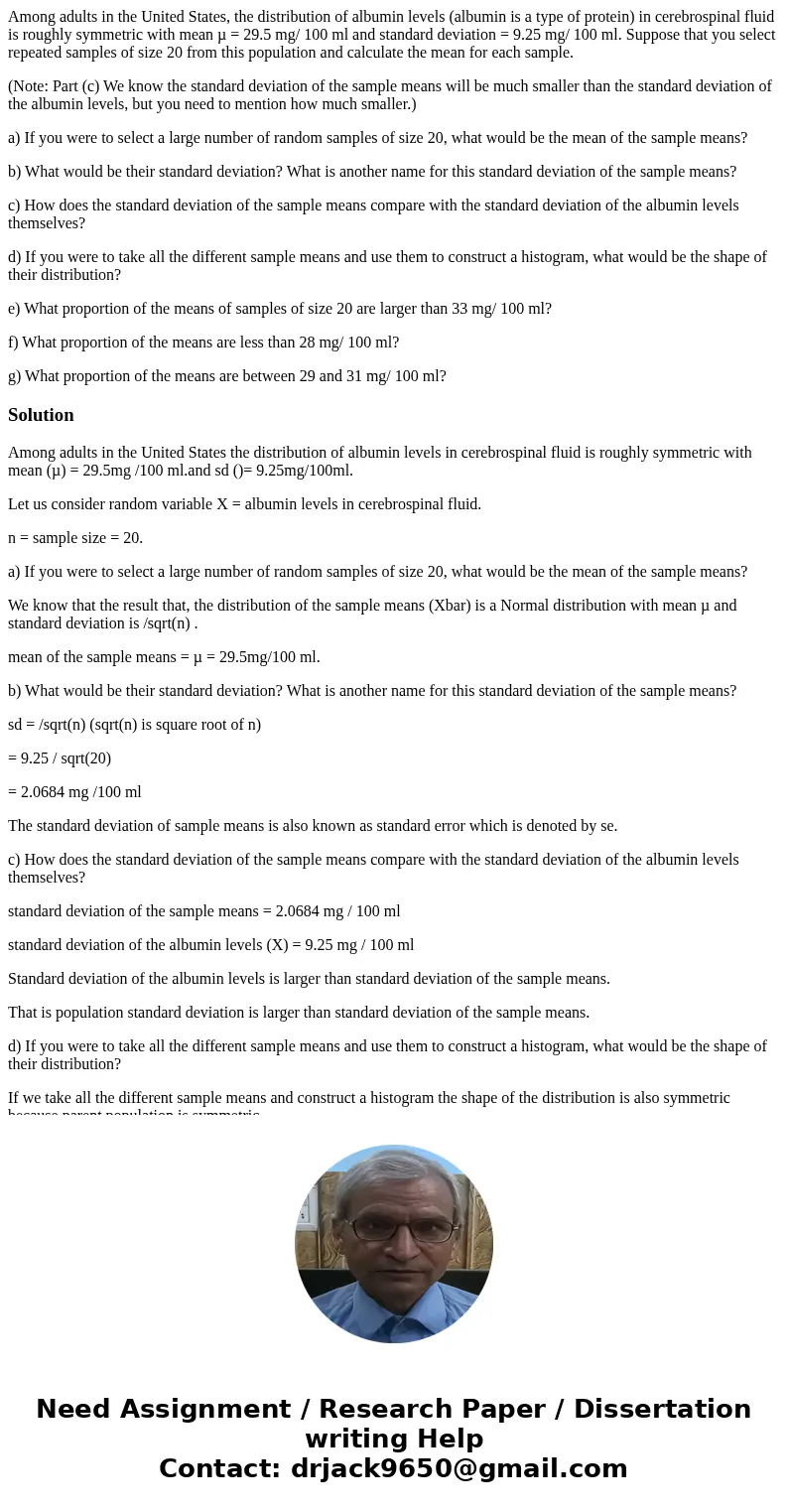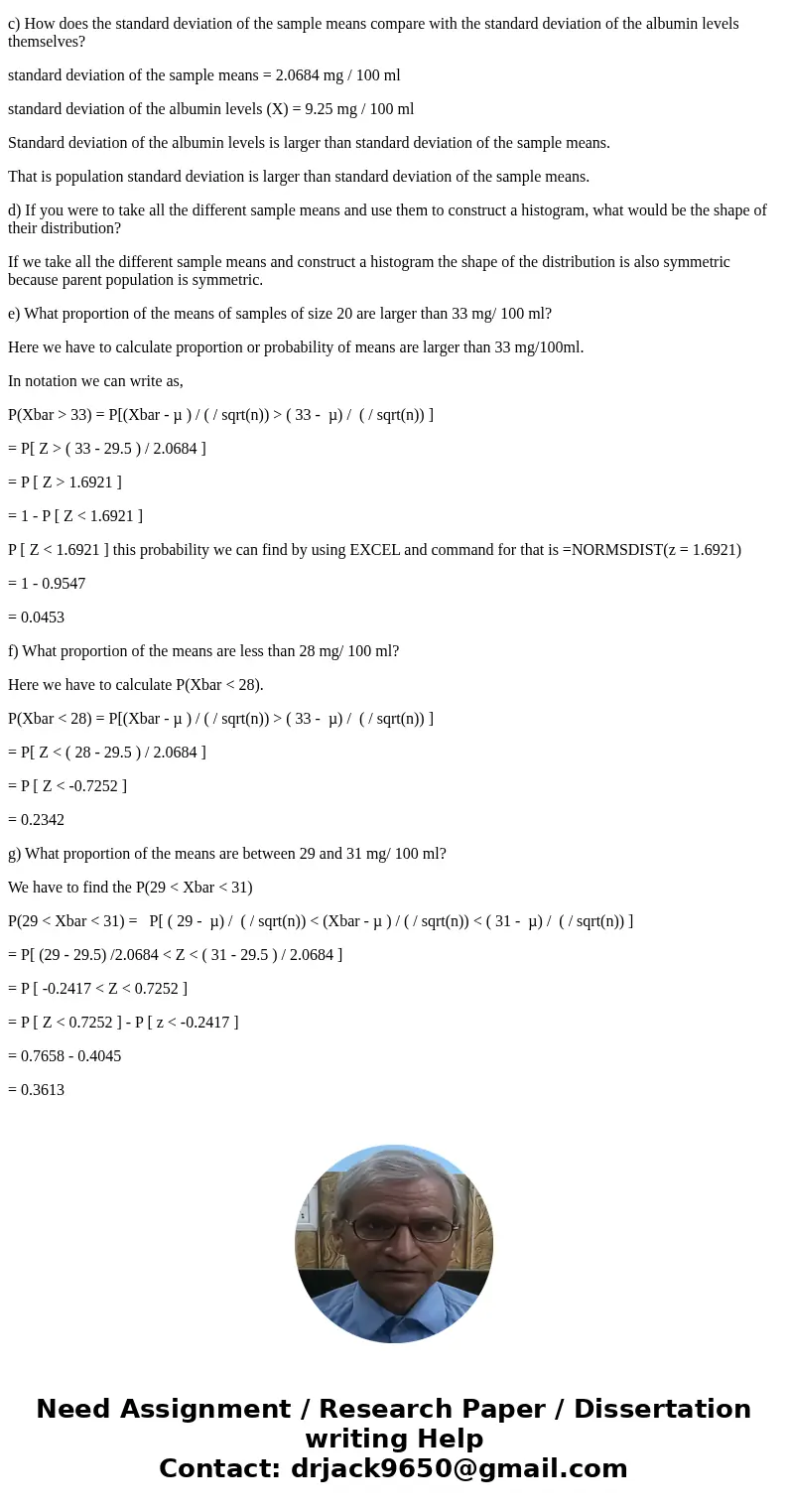Among adults in the United States the distribution of albumi
Among adults in the United States, the distribution of albumin levels (albumin is a type of protein) in cerebrospinal fluid is roughly symmetric with mean µ = 29.5 mg/ 100 ml and standard deviation = 9.25 mg/ 100 ml. Suppose that you select repeated samples of size 20 from this population and calculate the mean for each sample.
(Note: Part (c) We know the standard deviation of the sample means will be much smaller than the standard deviation of the albumin levels, but you need to mention how much smaller.)
a) If you were to select a large number of random samples of size 20, what would be the mean of the sample means?
b) What would be their standard deviation? What is another name for this standard deviation of the sample means?
c) How does the standard deviation of the sample means compare with the standard deviation of the albumin levels themselves?
d) If you were to take all the different sample means and use them to construct a histogram, what would be the shape of their distribution?
e) What proportion of the means of samples of size 20 are larger than 33 mg/ 100 ml?
f) What proportion of the means are less than 28 mg/ 100 ml?
g) What proportion of the means are between 29 and 31 mg/ 100 ml?
Solution
Among adults in the United States the distribution of albumin levels in cerebrospinal fluid is roughly symmetric with mean (µ) = 29.5mg /100 ml.and sd ()= 9.25mg/100ml.
Let us consider random variable X = albumin levels in cerebrospinal fluid.
n = sample size = 20.
a) If you were to select a large number of random samples of size 20, what would be the mean of the sample means?
We know that the result that, the distribution of the sample means (Xbar) is a Normal distribution with mean µ and standard deviation is /sqrt(n) .
mean of the sample means = µ = 29.5mg/100 ml.
b) What would be their standard deviation? What is another name for this standard deviation of the sample means?
sd = /sqrt(n) (sqrt(n) is square root of n)
= 9.25 / sqrt(20)
= 2.0684 mg /100 ml
The standard deviation of sample means is also known as standard error which is denoted by se.
c) How does the standard deviation of the sample means compare with the standard deviation of the albumin levels themselves?
standard deviation of the sample means = 2.0684 mg / 100 ml
standard deviation of the albumin levels (X) = 9.25 mg / 100 ml
Standard deviation of the albumin levels is larger than standard deviation of the sample means.
That is population standard deviation is larger than standard deviation of the sample means.
d) If you were to take all the different sample means and use them to construct a histogram, what would be the shape of their distribution?
If we take all the different sample means and construct a histogram the shape of the distribution is also symmetric because parent population is symmetric.
e) What proportion of the means of samples of size 20 are larger than 33 mg/ 100 ml?
Here we have to calculate proportion or probability of means are larger than 33 mg/100ml.
In notation we can write as,
P(Xbar > 33) = P[(Xbar - µ ) / ( / sqrt(n)) > ( 33 - µ) / ( / sqrt(n)) ]
= P[ Z > ( 33 - 29.5 ) / 2.0684 ]
= P [ Z > 1.6921 ]
= 1 - P [ Z < 1.6921 ]
P [ Z < 1.6921 ] this probability we can find by using EXCEL and command for that is =NORMSDIST(z = 1.6921)
= 1 - 0.9547
= 0.0453
f) What proportion of the means are less than 28 mg/ 100 ml?
Here we have to calculate P(Xbar < 28).
P(Xbar < 28) = P[(Xbar - µ ) / ( / sqrt(n)) > ( 33 - µ) / ( / sqrt(n)) ]
= P[ Z < ( 28 - 29.5 ) / 2.0684 ]
= P [ Z < -0.7252 ]
= 0.2342
g) What proportion of the means are between 29 and 31 mg/ 100 ml?
We have to find the P(29 < Xbar < 31)
P(29 < Xbar < 31) = P[ ( 29 - µ) / ( / sqrt(n)) < (Xbar - µ ) / ( / sqrt(n)) < ( 31 - µ) / ( / sqrt(n)) ]
= P[ (29 - 29.5) /2.0684 < Z < ( 31 - 29.5 ) / 2.0684 ]
= P [ -0.2417 < Z < 0.7252 ]
= P [ Z < 0.7252 ] - P [ z < -0.2417 ]
= 0.7658 - 0.4045
= 0.3613


 Homework Sourse
Homework Sourse